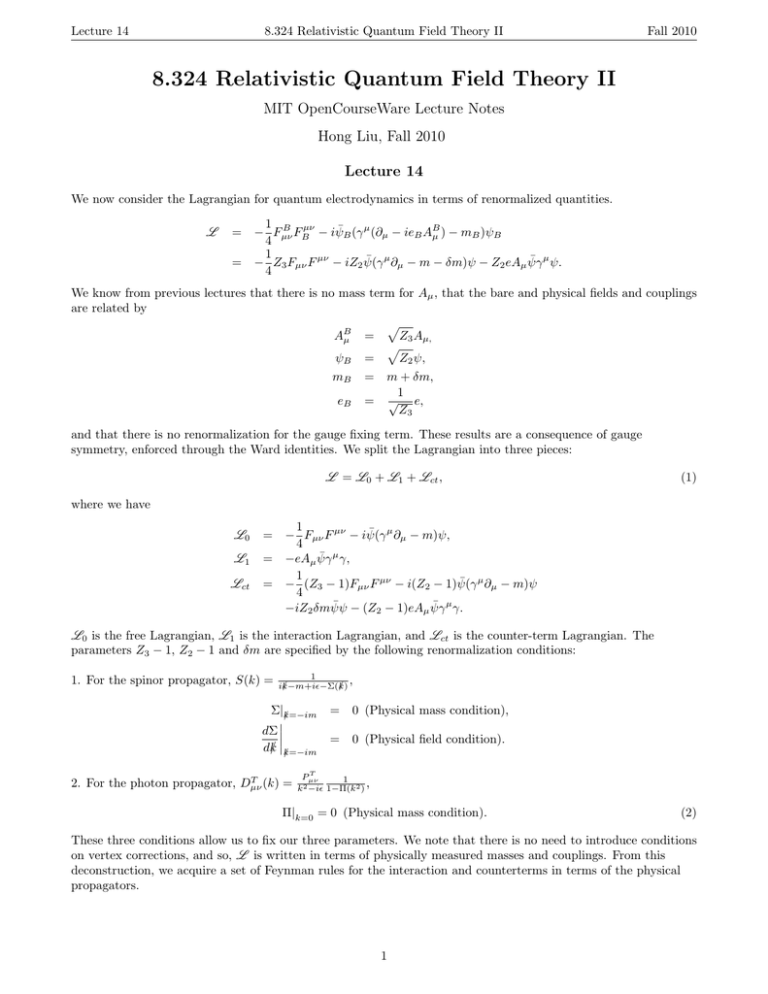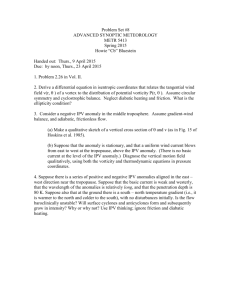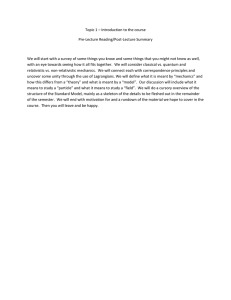8.324 MIT OpenCourseWare Lecture Notes Hong Liu, Fall 2010 Lecture
advertisement

Lecture 14
8.324 Relativistic Quantum Field Theory II
Fall 2010
8.324 Relativistic Quantum Field Theory II
MIT OpenCourseWare Lecture Notes
Hong Liu, Fall 2010
Lecture 14
We now consider the Lagrangian for quantum electrodynamics in terms of renormalized quantities.
L
1 B µν
= − Fµν
FB − iψ̄B (γ µ (∂µ − ieB AB
µ ) − mB )ψB
4
1
¯ µ ∂µ − m − δm)ψ − Z2 eAµ ψγ
¯ µ ψ.
= − Z3 Fµν F µν − iZ2 ψ(γ
4
We know from previous lectures that there is no mass term for Aµ , that the bare and physical fields and couplings
are related by
√
AB
=
Z3 Aµ,
µ
√
ψB =
Z2 ψ,
mB
=
eB
=
m + δm,
1
√ e,
Z3
and that there is no renormalization for the gauge fixing term. These results are a consequence of gauge
symmetry, enforced through the Ward identities. We split the Lagrangian into three pieces:
L = L0 + L1 + Lct ,
(1)
where we have
L0
=
L1
=
Lct
=
1
− Fµν F µν − iψ̄(γ µ ∂µ − m)ψ,
4
¯ µ γ,
−eAµ ψγ
1
− (Z3 − 1)Fµν F µν − i(Z2 − 1)ψ̄(γ µ ∂µ − m)ψ
4
¯ µ γ.
¯ − (Z2 − 1)eAµ ψγ
−iZ2 δmψψ
L0 is the free Lagrangian, L1 is the interaction Lagrangian, and Lct is the counter-term Lagrangian. The
parameters Z3 − 1, Z2 − 1 and δm are specified by the following renormalization conditions:
1. For the spinor propagator, S(k) =
1
/−m+iϵ−�(k
/) ,
ik
Σ|k/=−im
dΣ dk/ k/=−im
T
2. For the photon propagator, Dµν
(k) =
=
0 (Physical mass condition),
=
0 (Physical field condition).
T
Pµ�
1
k2 −iϵ 1−�(k2 ) ,
Π|k=0 = 0 (Physical mass condition).
(2)
These three conditions allow us to fix our three parameters. We note that there is no need to introduce conditions
on vertex corrections, and so, L is written in terms of physically measured masses and couplings. From this
deconstruction, we acquire a set of Feynman rules for the interaction and counterterms in terms of the physical
propagators.
1
Lecture 14
8.324 Relativistic Quantum Field Theory II
p
p
=
−igµν
,
k 2 + iϵ
=
1
,
i/
k − m + iϵ
Fall 2010
= −ieγ µ ,
p
p
= −i(Z3 − 1)(k 2 g µν − k µ k ν ) ∼ O(e2 ),
= −i(Z2 − 1)(ik/ − m) + Z2 δm ∼ O(e2 ),
= −i(Z2 − 1)eγ µ ∼ O(e3 ).
(3)
3.2: VERTEX FUNCTION
Consider the effective vertex we defined before:
k
Γµphys (k, k)
=
µ
≡ −iephys γ µ .
k
(4)
This is the physical vertex: it captures the full electromagnetic properties of a spinor interacting with a photon.
As we showed in the previous lecture, the Ward identities impose that
Γµ (k, k) = −ieγ µ
(5)
when k is on-shell, with e = �1Z eB being the physical charge. We note that in this case, q = 0, and so this is an
3
interaction with a static potential, measuring electric charge. We will now proceed to examine the general
structure of Γµ (k1 , k2 ), with k1 and k2 on-shell. We will discuss the physical interpretation, and we will compute
the one-loop correction explicitly. For general k12 = k22 = −m2 , q 2 = (k2 − k1 )2 ̸= 0, the process being described is
an electron interacting a general external electromagnetic field. From Lorentz invariance, we can build Γµ from
γ µ , k1µ and k2µ . Hence,
iΓµ (k1 , k2 ) = γ µ A + i(k2µ + k1µ )B + (k2µ − k1µ )C,
(6)
where A, B, and C are 4 × 4 matrix functions of k1 and k2 . But, since k1 and k2 are on-shell, and Γµ always
appears in a product as
ūs′ (k2 )Γµ (k1 , k2 )us (k1 )
µ
(7)
where us′ (k1 ) and ūs (k2 ) are on-shell spinor wave functions, we can then simplify Γ with the understanding that
it will always be found in this combination, using the on-shell spinor identities
/ s (k)
ku
ūs (k)k/
=
−imus (k),
=
−imūs (k).
2
Lecture 14
8.324 Relativistic Quantum Field Theory II
Fall 2010
Hence, A, B, and C are scalars, and functions of the scalars k12 , k22 and k1 .k2 , or, equivalently, of q 2 and m. From
the Ward identities, we have that
qµ Γµ = 0,
(8)
and, as ūs′ (k2 )/qus (k1 ) = 0, and qµ (k1µ − k2µ ) = 0, only the term in C on the left-hand side is non-zero. We therefore
have C = 0. It is common to rewrite Γµ using the Gordon identity. Defining σ µν = 2i [γ µ , γ ν ] , this result states
ūs′ (k2 )γ µ us (k1 ) =
i
ūs′ (k2 ) [(k1µ + k2µ ) + iqν σ µν ] us (k1 ).
2m
(9)
This allows us to exchange the term in B for a term in σ µν .
Proof
ūs′ (k2 )γ µ us (k1 )
i
[ūs′ (k2 )γ µ k/1 us (k1 ) + ūs′ (k2 )k/2 γ µ us (k1 )]
2m [(
)
i
k2v + k1v
k2v − k1v
=
−
ūs′ (k2 )γ µ γ ν us (k1 )
2m
2
2
(
)
]
k2v + k1v
k2v − k1v
+
+
ūs′ (k2 )γ v γ µ us (k1 )
2
2
[(
)
(
)
]
i
k2v + k1v
k2v − k1v
=
ūs′ (k2 )
{γ µ , γ ν } −
[γ µ , γ ν ] us (k1 )
2m
2
2
i
=
ūs′ (k2 ) [(k2µ + k1µ ) + iqv σ µν ] us (k1 ).
2m
=
�
From this, we find that
[
]
σ µν qν
µ
2
2
iΓ (k1 , k2 ) = e γ F1 (q ) −
F2 (q ) .
2m
µ
(10)
F1 (q 2 ) and F2 (q 2 ) are known as form factors. We have that eF1 (q 2 ) = A + 2mB, and eF2 (q 2 ) = −2mB. Note that
the Ward identity means that F1 (0) = 1 exactly.
3
MIT OpenCourseWare
http://ocw.mit.edu
8.324 Relativistic Quantum Field Theory II
Fall 2010 For information about citing these materials or our Terms of Use, visit: http://ocw.mit.edu/terms.




